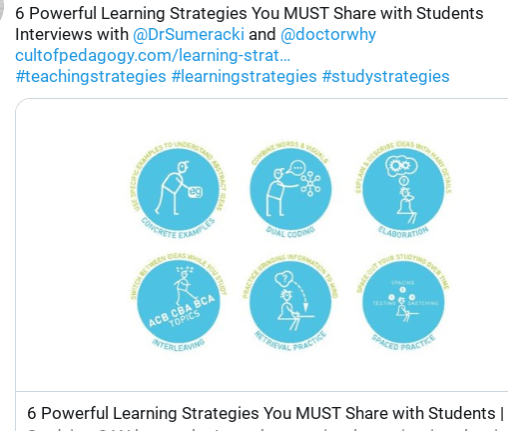Weekend Ed. Quote ~ November 1
#GCUTEC544 #GCUTEC595 #GCUTEC516 #GCUTEC521
#CUNE604, #CUNE605
Nov
1
#GCUTEC544 #GCUTEC595 #GCUTEC516 #GCUTEC521
#CUNE604, #CUNE605
Nov
6
Here is an updated video review of the Constructivism and Constructionism Learning Theories.
The video features a Microsoft digital storytelling app for creating interactive presentation called Sway. Here is the Sway link if you would like to scroll through at your own pace: https://tinyurl.com/TeagueSwayPVP
Vimeo video link: https://vimeo.com/teaguetech/piagetvygotskypapert?share=copy
Please note: This is a video excerpt from a Webinar I gave for graduate students and presented onsite in Tampere, Finland and Dublin, Ireland. This is a very low-tech, summary version of a much longer conference presentation. Participant questions and discussion are edited and gaps may be present. The video has been edited for time and content. Some edits are choppy and will never win awards. 🙂
Nov
6
This post addresses more uses of Word Clouds for Constructivist Learning opportunities.
Word Clouds are visual representations for text data, typically used to depict keyword metadata (tags) on websites or other digital documents. What counts with word clouds are the frequency with which a word is used. Word clouds are also known as Tag Clouds.
Word cloud usage, design, and discussion offers multiple options for Differentiation. For concept retention, students (almost all ages), can collaboratively share 2-3 key words from reading assignments. The Instructional Leader can create a word cloud of the shares. Here is a recent word cloud of key words generated from a small group, university discussion on ethical practices in research design. This word cloud was made last night using MonkeyLearn.
Another favorite way to use Word Clouds is to help graduate students in their job searches. I copy the text of a resume and paste it into a Word Cloud Generator, such as MonkeyLearn. When I copy the text into a word cloud generator, common themes and experiences immediately appear.

For concept retention, students (almost all ages), can collaboratively share 2-3 key words from reading assignments. The Instructional Leader can create a word cloud of the shares. Here is a recent word cloud of key words generated from a small group, university discussion on ethical practices in research design. This word cloud was made using MonkeyLearn.
Small, student groups with digital access can also complete this process and create their word clouds. Word clouds can then be shared with discussion to follow on the similarities and differences.
Michael Gorman gives 108 additional ways to use Word Clouds in the Classroom in this post in 21st Century Tech.
To read all Gorman’s suggestions, please Click here.
Learn More: 12 Valuable Wordle Tips You Must Read…Word Clouds in Education Series: Part 1
Please note: This is an updated post- Review/Read the Original post from August 17, 2012
Here is another 10-Rep Learning blog post on the engaging power of word clouds: Another post on Word Clouds
Oct
20
References
Piaget, J. (1955). The construction of reality in the child. Journal of Consulting Psychology, 19(1), 77
#PeaceSchema #GCUTEC544 #GCUTEC595 #GCUTEC516 #GCUTEC521
#CUNE607 #CUNE604, #CUNE605
#PBSReaders4Life
Sep
6
To view in fullscreen, please click here
Jun
27
In some of my graduate classes, we have been reading about virtual and digital learning and tools to use in instructional practice.
ChatGPT, an artificial intelligence chat bot from the company OpenAI came into the spotlight in 2022. ChatGPT is one of a few generative text aggregators available to the public (Dehouche, 2021; Rutter & Mintz, 2023).
Generative text renderers such as ChatGPT, can generate collections of information, and some schools are banning the tool from its devices and networks altogether (Korn & Kelly, 2023).
Some of the ways that generative text can theoretically be used include the following (Dehouche, 2021. Korn & Kelly, 2023; Rutter & Mintz, 2023; Washburn, 2023)… but is this ethical?
Although the ChatGPT marketing indicates that it generates “original” writing, it does not do this because it is solipsistic, or existing only within itself and therefore not reflecting peer-reviewed sources (Teague, 2023). Instead, artificial intelligence chatbots, such as ChatGPT, assembles and renders content based on sources indexed online, based on the prompts it is provided. This process is similar to compiling a Playlist, mixed , or mixed tape. The sources used in compilation may or may not be copyright-free and they may not be peer-reviewed.
References
Dehouche, N. (2021). Plagiarism in the age of massive generative pre-trained transformers (GPT-3). Ethics in Science and Environmental Politics, (2), 17–23. https://doi.org/10.3354/esep00195
Korn, J. & Kelly, S. (2023). New York City public schools ban access to AI tool that could help students cheat. CNN Business. https://www.cnn.com/2023/01/05/tech/chatgpt-nyc-school-ban/index.html
Quora (2023). Etymology of the word solipsism. https://www.quora.com/What-is-the-etymology-of-the-word-solipsism
Rutter, M.P. & Mintz, S. (2023). ChatGPT: Threat or menace? Higher Ed Gamma.
Washburn, B. (2023) How Teachers can use ChatGPT to assess students and provide feedback. Brittany Washburn.com blog. https://brittanywashburn.com/2023/03/how-teachers-can-use-chatgpt-to-assess-students-and-provide-feedback/#:~:text=ChatGPT%20is%20an%20AI%2Dbased,provide%20feedback%20efficiently%20and%20accurately.
To cite this post: Teague, H. (2023). The Solipsism of generative AI. 10RepLearning blog. https://4oops.edublogs.org/2023/06/27/the-solipsism-of-generative-ai/
Mar
27
This is a follow-up, perspective post.
Many graduate students are pursuing advanced degrees (Masters/Doctorate) in fields that are different from their original undergraduate major. Further, these advanced degree pursuits occur in online learning environments, which are also instructional spaces that are different from their traditional location of learning.
The result is a nexus of new concepts in new environments. This is a challenge of dual proportions. Andragogical themes and characteristics, first studied and shared by Malcolm Knowles in the foundational The Adult Learner are helpful learning approaches.
Research surrounding the acquisition of content helps to temper expectations surrounding content integration. All new ideas begin with specialized words, best learned through repeated repetitive practice.
The research team of Ausubel and Youssef (1965) indicated that 17 exposures were needed to learn a new word. Ausubel and Youssef’s research is echoed in Kamil, et al. (2008) and IES Practice Guide (2008) which suggests that words are usually learned only after they appear several times. In fact, researchers estimate that it could take as many as 17 exposures for a student to learn a new word.
Of course, many factors affect learning and if ever an advertising slogan applies to the intricate pursuit of new knowledge, then “your mileage may vary” certainly holds sway.
The enduring value of learning is that it is important, especially for adult learners, to realize that the one rep. “One and done” approach has not been successful, at least from a research standpoint. the best way to become familiar with any new topic, idea, or concept is to revisit it frequently and find immediate ways to include the topic, idea, concept into current practice. My Grandma would often tell us kids to use a new idea within 24 hours and every 24 hours until we forgot it was new. My Grandma attended formal school only through the third grade, but she remains one of the wisest people in my life.
Action Suggestion: Please share your research or research that you’ve discovered on the subject of learning repetitions in the moderated comments.
References
Ausubel, D.P., & Youssef, M. (1965). The effect of spaced repetition on meaningful retention. The Journal of General Psychology, 73(1), 147-150.
IES Practice Guide (2008). Improving adolescent literacy: Effective classroom intervention, https://ies.ed.gov/ncee/wwc/Docs/PracticeGuide/adlit_pg_082608.pdf
Kamil, M. L., Borman, G. D., Dole, J., Kral, C. C., Salinger, T., and Torgesen, J. (2008). Improving adolescent literacy: Effective classroom and intervention practices: A Practice Guide (NCEE #2008-4027). Washington, DC: National Center for Education Evaluation and Regional Assistance, Institute of Education Sciences, U.S. Department of Education. https://ies.ed.gov/ncee/wwc/PracticeGuide/8
Knowles, M. S., Holton III, E. F., Swanson, R. A., Swanson, R., & Robinson, P. A. (2020). The adult learner: The definitive classic in adult education and human resource development. Google Books.
Apr
10
One of the many setbacks of the past two years is the learning voids among students who were kept home and not in school or other learning environments.
Perhaps our society forgot that “children don’t think like adults” (Papert, 1999) and their needs, especially for social connections are vastly different from adults (Piaget, 1966). The earlier works of Vygotsky and later works of Bruner (1968), Papert, Lave and Wenger form a continuum of social-emotional learning.
Children learn to talk by … talking (Bruner, 1968). The human voice in real-time is preferred. Along with talking, we must utilize question wait time and active listening.
~~~
Educators (and those who love them) can use EdTech Digital tools to catalyst the process of student talk in learning environments.
Here is a list of reliable online strategy “How-To’s”
Chatting It Up: How to Increase Student Talk Time in The ESL Classroom from Concordia University- https://www.cune.edu/academics/resource-articles/chatting-it-how-increase-student-talk-time-esl-classroom
9 Strategies for Getting More Students to Talk from Edutopia – https://www.edutopia.org/article/9-strategies-getting-more-students-talk
The Big List of Class Discussion Strategies, by Jennifer Gonzalez at Cult of Pedagogy – https://www.cultofpedagogy.com/speaking-listening-techniques/
Structured Student Talk from CCOE- https://www.scoe.org/files/el14-structured-student-talk-handout.pdf
Turn and Talk Strategy with Video Demonstrations from Teacher Toolkit – There is a Pre-K and older student version- https://www.theteachertoolkit.com/index.php/tool/turn-and-talk
References
Bruner, J. (1968). Child’s Talk: Learning to use language. Basic Books.
Concordia University (2019). Chatting it up: How to increase student talk time in the ESL classroom.
https://www.cune.edu/academics/resource-articles/chatting-it-how-increase-student-talk-time-esl-classroom
Gonzalez, J. (2015). The Big List of Classroom Discussion Strategie. Cult of Pedagogy. https://www.cultofpedagogy.com/speaking-listening-techniques/
Papert, S. (1999). Papert on piaget. Time magazine, pág, 105. https://ase.tufts.edu/DevTech/courses/readings/papertonpiaget.pdf
Piaget, J. and Inhelder, B. (1966). The psychology of the child. Basic Books.
Reid, R. (2019). 9 strategies for getting more students to talk. Edutopia. https://www.edutopia.org/article/9-strategies-getting-more-students-talk
Sonoma County Office of Education (SCOE), (2021). Structured Student Talk. https://www.scoe.org/files/el14-structured-student-talk-handout.pdf
TeacherToolKit: Turn and Talk Strategy (2014-2022). https://www.theteachertoolkit.com/index.php/tool/turn-and-talk
Teague, H. (2022). Learning Theory-> Vygotsky’s ZPD/MKO Constructivism and Paper’s Constructionsim. [VideoFile]. YouTube. https://www.youtube.com/embed/TnnBpiSNSeU
Apr
9
File Link: https://4oops.edublogs.org/files/2021/04/PapertP42.jpg
Feb
24
6 Powerful Learning Strategies that you must share with your students– Click here to read the link from the Cult of Pedagogy blog.
